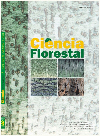
|
Ciência Florestal
Centro de Pesquisas Florestais - CEPEF, Departamento de Ciências Florestais - DCFL, Programa de Pós Graduação em Engenharia Florestal - PPGEF
ISSN: 0103-9954
EISSN: 0103-9954
Vol. 23, No. 2, 2013, pp. 355-363
|
 Bioline Code: cf13033
Bioline Code: cf13033
Full paper language: English
Document type: Research Article
Document available free of charge
|
|
|
Ciência Florestal, Vol. 23, No. 2, 2013, pp. 355-363
| en |
EVALUATION OF ANNATTO ( BIXA ORELLANA  L.) GENOTYPES THROUGH THE MORPHOLOGICAL CHARACTERISTICS OF FRUITS, SEEDS PRODUCTIVITY AND BIXIN CONTENT L.) GENOTYPES THROUGH THE MORPHOLOGICAL CHARACTERISTICS OF FRUITS, SEEDS PRODUCTIVITY AND BIXIN CONTENT
Mantovani, Nilton César; Grando, Magali Ferrari; Xavier, Aloisio & Otoni, Wagner Campos
Abstract
Bixa orellana

L. (annatto) is considered an important source of natural colorants for food, pharmaceutical
and textile industries and Brazil is one of the largest producers and exporters of this natural dye extracted
from this plant. The morphological characterization of fruits, evaluation of seed productivity and the content
of carotenoid bixin present in freshly harvested and stored seeds for periods of 30, 60, 90 and 120 days, were
performed on 10 genotypes of annatto to provide subsidies for the selection of superior genotypes for these
characteristics. There were variations in all evaluated characteristics between the 10 genotypes. The fruit
of all genotypes are covered with bristles or hairs, have reddish, green, yellow or red color, and two basic
forms, oval or lanceolate. The fruits had average lengths ranging from 3.1 to 4.8 cm, and widths between
2.4 to 3.1 cm. The average number of seeds per fruit ranged from 41.5 to 50.6. The mass of 100 seeds
varied from 1.1 to 2.24 g. There was significant difference in the concentration of bixin among genotypes,
being possible to identify genotypes with high levels of bixin carotenoid (5.05 %), superior to those already
reported by other studies. The content of bixin decreased with the increase in the period of storage of seeds.
Keywords
natural colorants; carotenoids; phenotypic variability
|
| |
| pt |
AVALIAĆÃO DE GENÓTIPOS DE URUCUM ( BIXA ORELLANA  L.) POR MEIO DA CARACTERIZAĆÃO MORFOLÓGICA DE FRUTOS, PRODUTIVIDADE DE SEMENTES E TEOR DE BIXINA L.) POR MEIO DA CARACTERIZAĆÃO MORFOLÓGICA DE FRUTOS, PRODUTIVIDADE DE SEMENTES E TEOR DE BIXINA
Mantovani, Nilton César; Grando, Magali Ferrari; Xavier, Aloisio & Otoni, Wagner Campos
Resumo
Bixa orellana

L. (urucum) é considerada uma fonte importante de corantes naturais para as indústrias
alimentícia, farmacêutica e têxtil, sendo o Brasil um dos maiores produtores e exportadores do corante
extraído das sementes desta planta. O objetivo deste trabalho foi a caracterização morfológica de frutos,
a avaliação da produtividade de sementes e do teor do carotenoide bixina presente nas sementes recémcolhidas
e armazenadas por períodos de 30, 60, 90 e 120 dias, realizada em 10 genótipos de urucum, a fim
de fornecer subsídios para a seleção de genótipos superiores para estas características. Houve variação em
todas as características avaliadas entre os 10 genótipos. Os frutos, de todos os genótipos, são recobertos por
cerdas ou pêlos, apresentam coloração avermelhada, verde, amarela ou vermelha e duas formas básicas,
oval ou lanceolada. Os frutos apresentaram comprimentos médios que variaram entre 3,1 a 4,8 cm e larguras
entre 2,4 a 3,1 cm. O número médio de sementes por fruto variou de 41,5 a 50,6. A massa de 100 sementes
variou de 1,1 a 2,24 g. Houve significativa diferença na concentração de bixina entre os genótipos, sendo
possível identificar genótipos com altos níveis deste carotenoide (5,05 %), superior aos já relatados por
outros estudos. O teor de bixina decresceu com o aumento no período de armazenamento das sementes.
Palavras-chave
corantes naturais; carotenoides; variabilidade fenotípica
|
| |
© Copyright 2013 - Ciência Florestal
Alternative site location: http://cascavel.ufsm.br/revistas/ojs-2.2.2/index.php/cienciaflorestal/index
|
|
